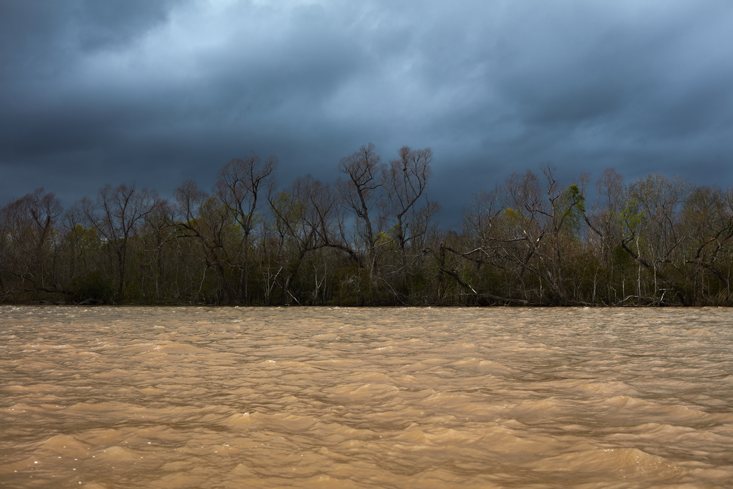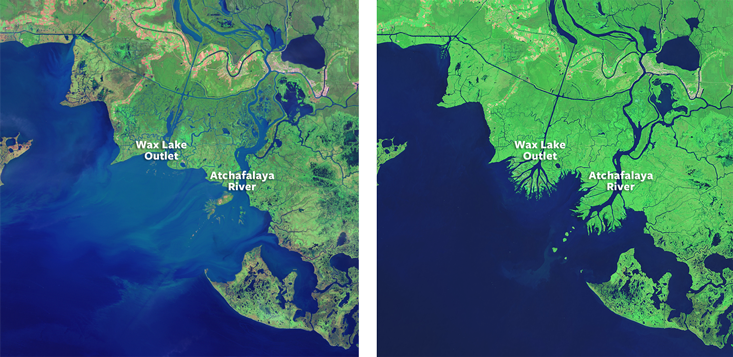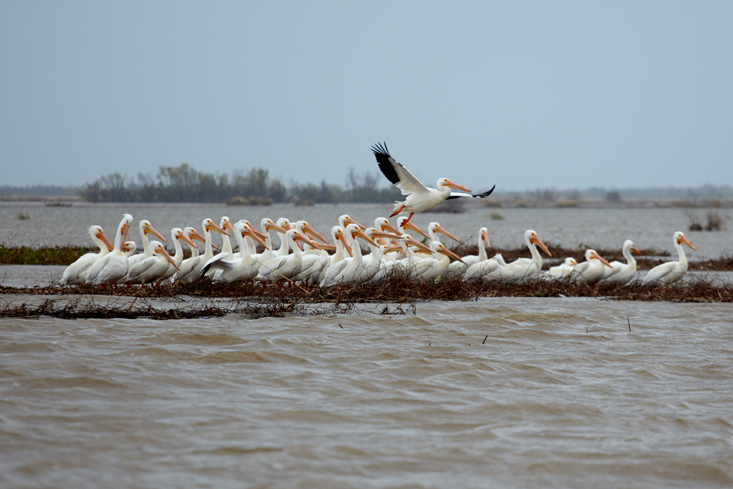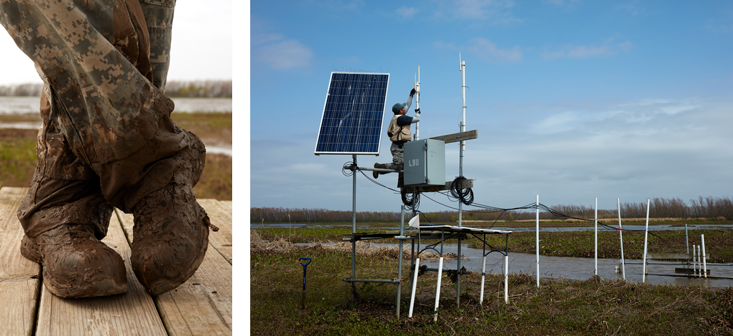To reach the youngest land in the United States you need a boat. Robert Twilley still vividly remembers the first time he made the trip. The Louisiana State University coastal ecologist piled into a 24-foot Boston Whaler with a bunch of geomorphologists from Minnesota and motored out to an arc of spongy islands along the central coast of Louisiana called the Wax Lake Delta. It was the best place to learn about how a delta develops. The way the land eventually stabilizes and becomes home to a unique ecosystem that changes as the delta gets older is a process that ecologists call succession. “Succession is one of the most fascinating concepts in ecology,” said Twilley, “though one of the hardest to study. But in the Wax Lake Delta you can see it all. Biologic communities link up A to Z; it is the holy grail of ecosystem succession.”
What is remarkable for scientists like Twilley is that with good muck boots, a small boat, and a non-aversion to intense sun, freak thunderstorms, biting insects, and devastating humidity, the aging process of this new land can be studied in a human lifespan. In just over 40 years, the Wax Lake Delta has grown from nothing to an area twice the size of Manhattan. Meanwhile, since the European settlement of North America, the Mississippi River Delta has lost approximately one-third of its original wetland area. A delta that was once about twice the size of Delaware and on maps resembled a head of cauliflower now looks more like a string bean. The slow death of the Mississippi River Delta has severe consequences, including reduced hurricane protection for cities like New Orleans. Not only an important food source for humans and wildlife, this rich habitat also helps filter pollutants and absorb excess nutrients that would deplete the oxygen in the Gulf of Mexico’s water.

As one delta dies, another one grows. The budding Wax Lake Delta has allowed Twilley and his team of researchers to study how a delta ages. First, the nascent delta takes shape as lobes of sediment accumulate below the water. The delta is born when it breaches the surface of the water. Colonized by plants that gradually enhance the soil’s organic content and raise its elevation, it rolls through childhood. And eventually, it grows into a landscape able to support large shrubs and black willow trees. “The delta is almost like an organism,” says Twilley, “There is a birthing, there is an aging process, and there is a death.”
Birth
Like many births, the Wax Lake Delta was something of an accident. In the 1930s, Morgan City, Louisiana was the economic hub of Cajun Country, where muskrat trappers, moss pickers, frog hunters, shrimpers, and lumbermen came in from the swamps to sell their wares and swill their profits. Meanwhile, back in the swamps roamed by bears and gators, a reddish brown liquid, which a century prior had been worthless, was beginning to be siphoned out of the muck—oil. As it was unearthed, this marshy metropolis boomed.
But there was a problem. Morgan City was perched on the lower reaches of the Atchafalaya River—a distributary of the Mississippi, branching off from the mighty river in central Louisiana and taking its own path south to the Gulf—and it flooded regularly. In 1941, to alleviate the flooding, the U.S. Army Corps of Engineers dredged a shortcut to the Gulf of Mexico called the Wax Lake Outlet, diverting about one-third of the Atchafalaya’s flow.
The Atchafalaya has been a Mississippi distributary for at least 450 years, though for centuries its entrance was choked off by a 20-mile-long logjam, likely accumulated from trees swept regularly into the river from eroded banks. In 1839, local residents attempted to remove the blockage by setting it on fire. They destroyed, according to a government report, an “immense mass of timber” and “thousands of alligators”—but the logjam remained. Finally, during the early 1840s, the state cleared the epic jam with barges specially designed for the task, called “snagboats.” The Atchafalaya blossomed, and for the next century it continued to steal water and sediment from its parent river. “A steadily enlarging Atchafalaya River,” warned a 1952 U.S. Army Corps of Engineers report, “may eventually capture the entire Mississippi.” Such an event would have spelled disaster for cities like Baton Rouge and New Orleans, major port towns that suddenly would have lost their river, or at least a large part of it. To prevent that from happening, the Army Corps installed a system of floodgates in 1963.

Through the 1940s, ’50s, and ’60s, both rivers were depositing fine silts and clays into the bay, but the deltas had not yet breached the water’s surface. For that they needed sand. While it takes about 90 days for a drop of water to travel the length of the Mississippi, and a particle of fine sediment can make the trip in about a year, for a grain of sand to run the length of the river can take a century. That’s because silts and clays are carried suspended in the water, while coarser particles like sand are rolled, bounced, and jumped along the river bottom. Extreme flood events, though, can move a lot of sand quickly, which is exactly what happened during the Mississippi River flood of 1973.
“Dead animals were everywhere,” read one newspaper article, “some in trees, mostly deer and cows, and other critters too weak to fight the rapidly rising water.” Some 33 people also died, and there was more than $1 billion in damage. At the flood’s peak the flow rate of the Atchafalaya quadrupled, and the sediment load doubled, a boost that made its way into the Wax Lake Outlet, too. Where the waterway entered the Gulf, lobes of sandy land emerged. As Twilley sees it, this was the delta’s birth.
Adolescence and Maturity
On an early March morning a squall line is approaching the Louisiana coast, and I am standing with Edward Castaneda, one of Twilley’s research associates, at the foot of a boat ramp beside the Intracoastal Waterway, a 3,000-mile ribbon of water that runs just inland of the coast from Texas to New Jersey, intended as a sheltered shipping passage. We are about to depart on a small journey. On a brightly colored map of the Wax Lake Delta, Castaneda lays out our route into the new territory, untrammeled by all, except scientists and hunters—the entire delta is part of a state-run wildlife management area.
Aside from the occasional winter cold front or monster hurricane, the Gulf is relatively tranquil. Because the tidal range is also low, and the discharge rate of the Wax Lake Outlet is high, the Wax Lake Delta remains a freshwater system, with the morphology shaped largely by the flow of the Outlet itself. The delta is fan-shaped, and composed of long arrows of land, separated by channels that have split off from the main outlet. These arrow-shaped islands point upstream, and the tips are the highest, and oldest, parts. They began as sandy lobes that further slowed the river’s flow, helping to trap more sediment, and provided habitat for vegetation. Seeds arrived via the river, first subaqueous plants like longleaf pondweed, whose leaves rest on the surface, then lotus and arrowhead, plants with webby root systems that help trap and stabilize additional sediment. The delta’s largest plant species are black willows. For Twilley, their emergence represents the beginning of the delta’s adolescence.

Castaneda motors the Boston Whaler east along the Intracoastal, busy with barges carrying petrochemical products being pushed by sleek tugs. He is dressed for an excursion into some untrodden jungle, in camouflaged pants and dark shades. But the day’s main mission is actually light work: Fix a downed data-recording station on Mike Island, located roughly in the middle of the delta. At a four-way intersection of waterways so perfectly perpendicular I almost expect there to be stoplights, we turn right, and proceed south down the Wax Lake Outlet and toward the Gulf. Here, there’s virtually no river traffic. A warm wind buffets the bow; the squall line is getting closer, marking the leading edge of a storm system forecasted to last for three days and dump a foot of rain. The Outlet branches into two waterways, with a skein of low islands in the distance—we have entered the Wax Lake Delta.
To our right is Camp Island, one of the oldest parts of the delta, built atop sand deposited in the Mississippi River flood of 1973. There is a line of tall black willows on the upstream-facing side of the island, which has the highest elevation, and in this tiny forest are rabbits and deer. The land is even stable enough for a much larger type of organism, humans. A row of primitive hunting shacks occupies the island’s prime high ground, and fishermen come regularly to hook redfish, bass, and bluegill.
To call southern Louisiana solid ground is misleading; ground here is born of deltas, built upon layers of squishy sediments.
For the time being, the island is part of the delta, but eventually, sediment will choke the waterway separating it from the mainland and Camp Island will fuse with the coast. The mature stage of the delta also includes the formation of new coastal land. This process is what made all of the land in southeastern Louisiana, including New Orleans, and why graves in New Orleans are above ground and houses tend to list. The city is built not atop solid rock, like say New York City, but squishy deltaic sediments. And the fact that much of southeastern Louisiana is sinking away illustrates just how short-lived this mature stage of the delta can be; if land here is not getting replenished with new sediments, it is wasting away. Maturity, it appears, perhaps much as it is with human beings, is fleeting and precarious, a thin ridge between adulthood and a long slow march toward death.
But Azure Bevington, one of Twilley’s doctoral students, does not like to anthropomorphize the delta’s succession. “I think describing the delta with these rigid growth stages takes away from the complexity, and I would argue, the beauty of the system,” she says. Bevington describes a more chaotic succession, where the different parts don’t move with such linearity or purpose. Her research has shown that willows first emerge on the high sandy levees that form on the edges of the delta’s river channels during floods. The tip of Mike Island is lined with willows so uniform they look as if they were planted by a landscaper. Bevington believes they were probably seeded during several storms over the past 35 to 40 years. But curiously, as the island grows, new willow trees have not necessarily taken sprout. She thinks it is because the ground the willow seeds are falling on is already too thick with other vegetation, and thus the willow seeds are being outcompeted.
“Willows live to be 50 or 60 years but they are not regenerating themselves,” Bevington says. “So when the willows die what I think will happen, and this is purely untested hypothesis, but I think the land will be colonized by more shrubby vegetation.”
Maybe willows are not the peak, and like in a human life, physical robustness does not necessarily connote maturity. The climax of the delta, just like that of a human life, is perhaps more amorphous and unexpected. And perhaps aging itself is not a single arc toward a pre-defined destination, but an unsure wobble toward an unknown future.

Death
We are approaching Mike Island. The water is choppy and tinted orange, what I now know to be due to bits of clay, silt, and sand that have eroded off land somewhere upriver, potentially on the final leg of its journey to a new deltaic home.
Traveling with the sediments are nutrients, including nitrate fertilizer that runs off farms in Iowa, Illinois, and other Midwestern states each summer and is carried by the Mississippi into the Gulf of Mexico. There, it helps spawn algal blooms that use up oxygen supplies and can help cause a “dead zone” of oxygen-poor water that can grow to be the size of Connecticut and Rhode Island combined. These nitrates flow down the Wax Lake Outlet and into the Wax Lake Delta, where Twilley believes that the nitrates may actually be enhancing the growing vegetation on the delta. This is a good thing, he explains, because the more nitrates that get clogged up in the delta, the less are available to flow out into the Gulf and exacerbate the dead zone. One more largely unknown ecosystem service the delta is performing for us.
As the clouds are thickening, Castaneda ties up to a Spanish moss-draped black willow near the tip of Mike Island. We have moored just beside a small tidal creek, one of many that help funnel sediment from a main outlet channel into the island’s watery interior. This one happens to contain a baby alligator. Jumping off the bow of the boat I half-expect to sink right through the nascent island, born about 1990, but instead am greeted by spongy ground that sucks at my muck boots as I walk. Further proof that to call southern Louisiana solid ground is misleading; ground here is born of deltas, built upon layers of squishy sediments that, without continual replenishment, will eventually sink back beneath the waves.
That, of course, is exactly what is happening with the Mississippi River Delta, which continues to fray, eroding from wetland into the watery grave of the Gulf of Mexico. Presently, the Wax Lake Delta is growing faster than it is subsiding, though that could change in the near future, if subsidence, combined with sea level rise, outpaces the rate at which sediment is building up the delta. But sea level rise represents an unknown. “Certainly there is a tipping point,” said Twilley. “But I am not sure what it is, and I don’t think we will know until these phenomena play out.”
Later we get back in the boat and continue south toward the open Gulf, the island’s fringing line of willows slowly turning to marshy clumps. “All of this is still Mike,” says Castaneda, pointing to the petering-out island. Smooth massive logs stuck in the channel indicate that not just sediment has made the long trek from way upstream. And the sky continues to darken. The orange-tinged river glows electric against the stormy sky, and is now rippled with white caps. Raindrops begin to fall. The long-predicted storm has finally arrived. But for the Wax Lake Delta, that may be a good thing. Rain upriver means erosion, which means new sediment, and for the delta, that means growth. The youngest land in the United States will get even bigger.
Justin Nobel’s magazine articles on science and culture have been published in Best American Science and Nature Writing 2014 and Best American Travel Writing 2011, and 2016. This summer he will journey the Gulf and Atlantic coasts, documenting lifestyles and landscapes in the face of rising seas.






























